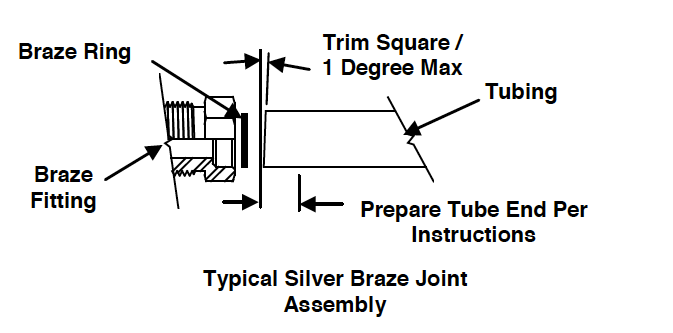Silver Brazed Tube Connections
NOTE: The following instructions are not intended to replace detailed brazing procedures or process plans. Only qualified personnel should attempt to braze hydraulic system assemblies. For any application, sufficient testing should be conducted and reviewed by the user and manufacturer to assure safe and satisfactory performance.

Download this section of the catalog here (PDF)
- Inspect components for damage or contamination .
- Tube end to be brazed should be trimmed square to within +/- 1 degree.
- Prepare tube end by sizing (if required) to achieve the recommended filler metal gap. Refer to braze alloy suppliers recommendations.
- De-burr tube O.D. and l.D .. Typical chamfer size should not exceed .020 x 45 degree.
- Clean all components with su itable degreasing solution to remove all oil/grease and loose contaminants. Following this degreasing step, avoid touching the braze joint surfaces with bare hands. Oil f.rom yo~r skin. may contaminate the joint and cause voids and inclusions.
- Mechanically clean or pickle surfaces to be brazed and braze filler material to remove surface oxides. Silicon carbide emery cloth may be used to polish joint surfaces, do not use abrasives containing aluminum oxide.
- Final degrease all components.
- Clamp or fixture tube assembly as required"
- Apply suitable flux to all components, following flux manufacturers recommendations.
- Assemble tube, braze ring (if used) and fitting components, reflux as required. Inspect to confirm proper placement of components prior to braze.
- Apply heat uniformly to bring the jo.int area up to. brazing temperature. Follow accepted industry practices for high quality braze joints. If specific brazing procedures have not been established for the fitting configurations being joined, refer to the flux and braze alloy manufacturers for recommendations.
- Allow braze alloy to solidify completely before quenching.
- Remove flux, following flux manufacturers instructions.
- Inspect joint. Joint should show no evidence of voids in the fillet and should have no excess braze on the flange sealing surface area. Fillets should be smooth and continuous around the entire joint.
- Proof test the assembly. Recommended proof pressure is two times the system operating pressure.
Note: System operating pressure should not exceed the rated operating pressure of the end connections, tubing and/or hose components.




